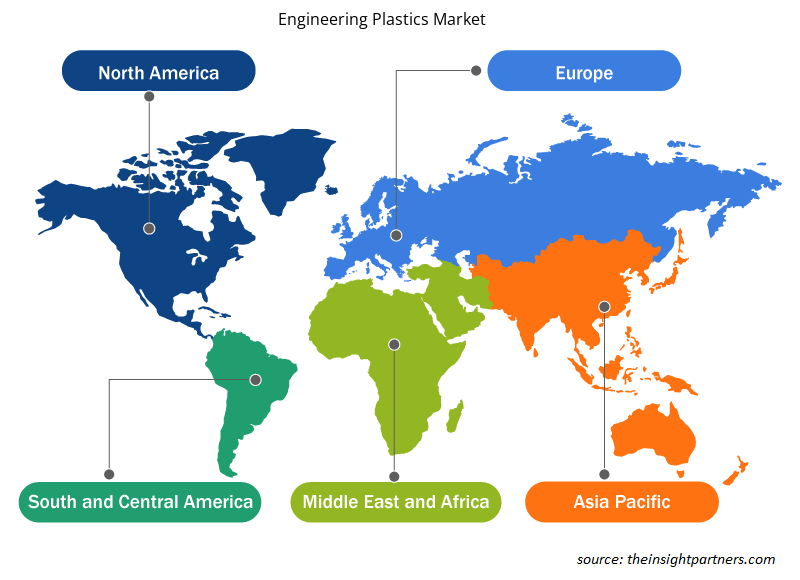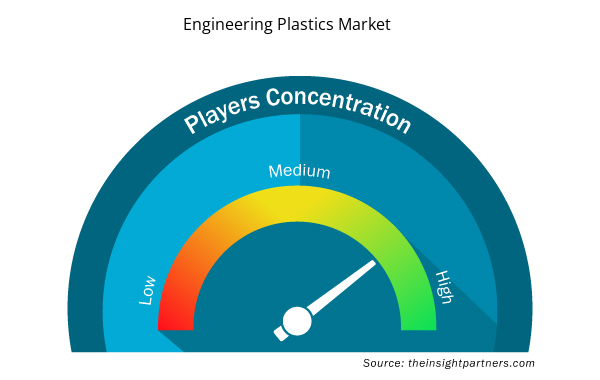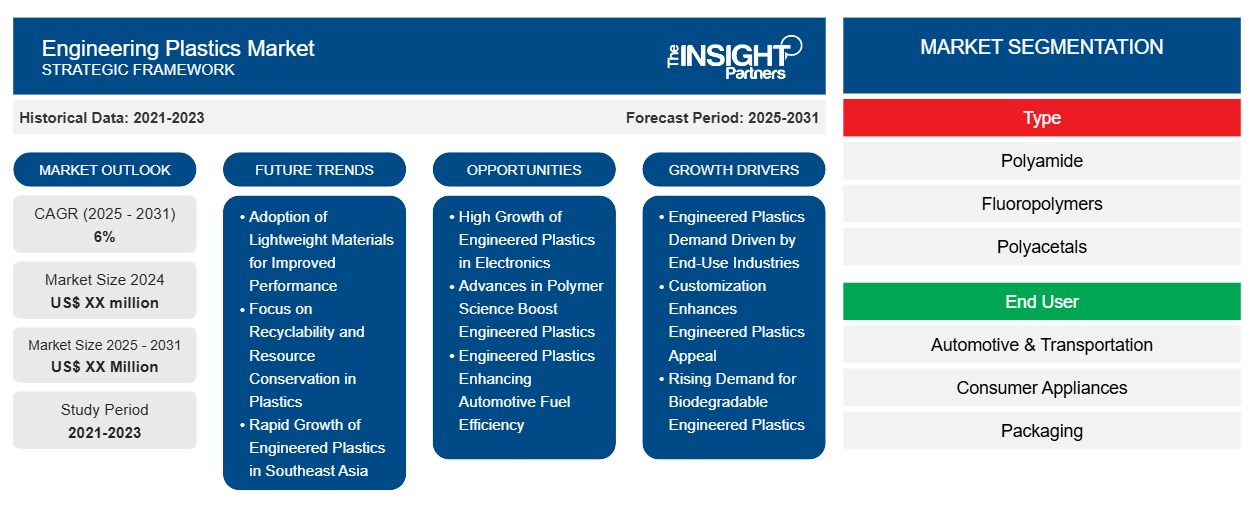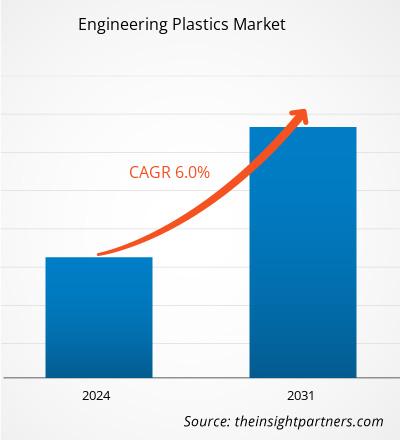Es wird erwartet, dass der Markt für technische Kunststoffe von 2023 bis 2031 eine durchschnittliche jährliche Wachstumsrate (CAGR) von 6 % verzeichnet und dass die Marktgröße von XX Millionen US-Dollar im Jahr 2023 auf XX Millionen US-Dollar im Jahr 2031 wächst.
Der Markt für technische Kunststoffe umfasst Analysen nach Typ ( Polyamid , Fluorpolymere , Polyacetale , thermoplastische Polyester und Polycarbonate ), Endverbraucher (Automobil und Transport, Haushaltsgeräte, Verpackung, Elektrik und Elektronik, Industrie und Maschinenbau und andere) und Geografie (Nordamerika, Europa, Asien-Pazifik, Naher Osten und Afrika sowie Süd- und Mittelamerika). Technische Kunststoffe sind eine Gruppe von Kunststoffmaterialien mit besseren mechanischen und thermischen Eigenschaften als Standardkunststoffe. Technische Kunststoffe werden in verschiedenen Anwendungen eingesetzt, die eine hohe Leistung in Bezug auf chemische und thermische Stabilität, Schlagfestigkeit, Dimensionsstabilität und mechanische Festigkeit erfordern.
Zweck des Berichts
Der Bericht „Technischer Kunststoffmarkt“ von The Insight Partners soll die aktuelle Situation und das zukünftige Wachstum sowie die wichtigsten treibenden Faktoren, Herausforderungen und Chancen beschreiben. Dies wird verschiedenen Geschäftspartnern Einblicke geben, wie zum Beispiel:
- Technologieanbieter/-hersteller: Um die sich entwickelnde Marktdynamik zu verstehen und die potenziellen Wachstumschancen zu kennen, damit sie fundierte strategische Entscheidungen treffen können.
- Investoren: Durchführung einer umfassenden Trendanalyse hinsichtlich der Marktwachstumsrate, der finanziellen Marktprognosen und der Chancen entlang der Wertschöpfungskette.
- Regulierungsbehörden: Zur Regulierung von Richtlinien und Überwachungsaktivitäten auf dem Markt mit dem Ziel, Missbrauch zu minimieren, das Vertrauen der Anleger zu bewahren und die Integrität und Stabilität des Marktes aufrechtzuerhalten.
Technische Kunststoffe Marktsegmentierung
Typ
- Polyamid
- Fluorpolymere
- Polyacetale
- Thermoplastische Polyester
- Polycarbonate
Endbenutzer
- Automobil und Transport
- Haushaltsgeräte
- Verpackung
- Elektrik und Elektronik
- Industrie & Maschinenbau
Passen Sie diesen Bericht Ihren Anforderungen an
Sie erhalten kostenlose Anpassungen an jedem Bericht, einschließlich Teilen dieses Berichts oder einer Analyse auf Länderebene, eines Excel-Datenpakets sowie tolle Angebote und Rabatte für Start-ups und Universitäten.
- Holen Sie sich die wichtigsten Markttrends aus diesem Bericht.Dieses KOSTENLOSE Beispiel umfasst eine Datenanalyse von Markttrends bis hin zu Schätzungen und Prognosen.
Wachstumstreiber auf dem Markt für technische Kunststoffe
- Nachfrage nach technischen Kunststoffen wird von Endverbrauchsbranchen getrieben: Die Hauptantriebskraft für die Nachfrage nach technischen Kunststoffen ist ihre breite Anwendung in verschiedenen Endverbrauchsbranchen wie Automobil, Elektrik und Elektronik, Industriemaschinen und Haushaltsgeräten. Die wichtigsten Nachfragetreiber werden jedoch von Automobilherstellern dominiert, die ständig nach Materialien suchen, die zur Verbesserung der Kraftstoffeffizienz beitragen und gleichzeitig die notwendige Festigkeit für eine höhere Leistung bieten.
- Anpassung steigert die Attraktivität technischer Kunststoffe: Einer der wichtigsten Wachstumstreiber auf diesem Markt ist die Möglichkeit, technische Kunststoffe auf eine Vielzahl von Anwendungen zuzuschneiden. Der Hersteller kann die besonderen Eigenschaften dieser Materialien so modifizieren, dass sie den recht unterschiedlichen Anforderungen der unterschiedlichsten Branchen gerecht werden und so ihre Attraktivität und Funktionalität deutlich verbessern.
- Steigende Nachfrage nach biologisch abbaubaren technischen Kunststoffen: In einer Zeit, in der Verbraucher und Hersteller auf Nachhaltigkeit setzen, wird die Nachfrage nach Biokunststoffen – also Kunststoffen aus erneuerbaren Ressourcen – voraussichtlich steigen. Die Einführung von technischen Kunststoffen mit biologisch abbaubarem Material wird umweltbewusste Kunden anziehen und steht im Einklang mit den weltweiten Bemühungen, eine Gesellschaft mit weniger Kunststoffabfällen aufzubauen.
Zukünftige Trends auf dem Markt für technische Kunststoffe
- Einsatz von Leichtbaumaterialien zur Leistungssteigerung: Generell wird in allen Anwendungsbereichen, wie oben zusammengefasst, in letzter Zeit zunehmend Wert auf Leichtbau gelegt. Leichtbauteile und Verbundwerkstoffe werden vor allem in der Fahrzeug- und Luftfahrtindustrie eingesetzt. Technische Kunststoffe sind eine allgemein positive Alternative zu Materialien wie Metallen. Durch die minimierte Verwendung dieser Materialien werden Gewichtsreduzierungen und eine daraus resultierende Gesamtenergieeffizienz erreicht.
- Fokus auf Recyclingfähigkeit und Ressourcenschonung bei Kunststoffen: Da Nachhaltigkeit heute für Hersteller – und natürlich auch für Verbraucher – wichtiger denn je ist, rücken die Recyclingfähigkeit von Produkten und ihre Umweltfreundlichkeit immer stärker in den Fokus. In diesem Zusammenhang können technische Kunststoffe als eine Möglichkeit betrachtet werden, Ressourcen zu schonen, Kunststoffabfälle angemessen zu reduzieren und Kreislaufwirtschaftspraktiken zu fördern.
- Schnelles Wachstum technischer Kunststoffe in Südostasien: In den Schwellenländern gibt es ein hohes Wachstum bei technischen Kunststoffen, wo aufgrund der schnellen Industrialisierung und Urbanisierung ein Anstieg zu beobachten ist. Indien und andere südostasiatische Länder benötigen ein enormes Wachstum bei Kunststoffen, obwohl die meisten Länder in diesen Sektoren ein ordentliches Wachstum verzeichnen.
Marktchancen für technische Kunststoffe
- Hohes Wachstum bei technischen Kunststoffen in der Elektronik: Der Elektro- und Elektroniksektor wächst mit einer sehr guten prognostizierten durchschnittlichen jährlichen Wachstumsrate von 8,09 %. Das Wachstum wird durch den kontinuierlichen Einsatz moderner Materialien und intelligenter Fertigungsverfahren vorangetrieben, was Hochleistungskunststoffe erfordert, die bei hohen Temperaturen funktionieren und elektrische Isolierung bieten.
- Fortschritte in der Polymerwissenschaft fördern technische Kunststoffe: Innovationen in der Polymerwissenschaft führen zu verbesserten Eigenschaften technischer Kunststoffe, die sie zu einem vielseitigeren Material für eine breite Palette von Anwendungen machen. Einige Verbesserungen umfassen Festigkeit und Hitzebeständigkeit sowie Beständigkeit gegen chemische Angriffe, die für aktuelle Fertigungstechniken erforderlich sind.
- Technische Kunststoffe verbessern die Kraftstoffeffizienz von Kraftfahrzeugen: In der Automobilindustrie werden zunehmend Leichtbaumaterialien eingesetzt, um die Kraftstoffeffizienz zu verbessern und die Emissionen von Fahrzeugen zu reduzieren. Technische Kunststoffe sind für das Design von Fahrzeugen unverzichtbar geworden und können in Innenraumkomponenten wie Innenverkleidungen und Außenverkleidungen sowie in Teile unter der Motorhaube integriert werden.
Regionale Einblicke in den Markt für technische Kunststoffe
Die regionalen Trends und Faktoren, die den Markt für technische Kunststoffe im Prognosezeitraum beeinflussen, wurden von den Analysten von Insight Partners ausführlich erläutert. In diesem Abschnitt werden auch die Marktsegmente und die Geografie für technische Kunststoffe in Nordamerika, Europa, im asiatisch-pazifischen Raum, im Nahen Osten und Afrika sowie in Süd- und Mittelamerika erörtert.

- Erhalten Sie regionale Daten zum Markt für technische Kunststoffe
Umfang des Marktberichts für technische Kunststoffe
| Berichtsattribut | Details |
|---|---|
| Marktgröße im Jahr 2023 | XX Millionen US-Dollar |
| Marktgröße bis 2031 | XX Millionen US-Dollar |
| Globale CAGR (2023 - 2031) | 6 % |
| Historische Daten | 2021-2022 |
| Prognosezeitraum | 2024–2031 |
| Abgedeckte Segmente | Nach Typ
|
| Abgedeckte Regionen und Länder | Nordamerika
|
| Marktführer und wichtige Unternehmensprofile |
|
Dichte der Marktteilnehmer für technische Kunststoffe: Die Auswirkungen auf die Geschäftsdynamik verstehen
Der Markt für technische Kunststoffe wächst rasant, angetrieben durch die steigende Nachfrage der Endverbraucher aufgrund von Faktoren wie sich entwickelnden Verbraucherpräferenzen, technologischen Fortschritten und einem größeren Bewusstsein für die Vorteile des Produkts. Mit steigender Nachfrage erweitern Unternehmen ihr Angebot, entwickeln Innovationen, um die Bedürfnisse der Verbraucher zu erfüllen, und nutzen neue Trends, was das Marktwachstum weiter ankurbelt.
Die Marktteilnehmerdichte bezieht sich auf die Verteilung der Firmen oder Unternehmen, die in einem bestimmten Markt oder einer bestimmten Branche tätig sind. Sie gibt an, wie viele Wettbewerber (Marktteilnehmer) in einem bestimmten Marktraum im Verhältnis zu seiner Größe oder seinem gesamten Marktwert präsent sind.
Die wichtigsten auf dem Markt für technische Kunststoffe tätigen Unternehmen sind:
- Covestro AG
- BASF SE
- Solvay
- Celanese Corporation
- LG Chem.
Haftungsausschluss : Die oben aufgeführten Unternehmen sind nicht in einer bestimmten Reihenfolge aufgeführt.

- Überblick über die wichtigsten Akteure auf dem Markt für technische Kunststoffe
Wichtige Verkaufsargumente
- Umfassende Abdeckung: Der Bericht deckt die Analyse von Produkten, Dienstleistungen, Typen und Endbenutzern des Marktes für technische Kunststoffe umfassend ab und bietet einen ganzheitlichen Überblick.
- Expertenanalyse: Der Bericht basiert auf dem umfassenden Verständnis von Branchenexperten und Analysten.
- Aktuelle Informationen: Der Bericht stellt durch die Abdeckung aktueller Informationen und Datentrends Geschäftsrelevanz sicher.
- Anpassungsoptionen: Dieser Bericht kann angepasst werden, um spezifische Kundenanforderungen zu erfüllen und die Geschäftsstrategien optimal anzupassen.
Der Forschungsbericht zum Markt für technische Kunststoffe kann daher dabei helfen, die Branchensituation und Wachstumsaussichten zu entschlüsseln und zu verstehen. Obwohl es einige berechtigte Bedenken geben kann, überwiegen die allgemeinen Vorteile dieses Berichts tendenziell die Nachteile.
- Historische Analyse (2 Jahre), Basisjahr, Prognose (7 Jahre) mit CAGR
- PEST- und SWOT-Analyse
- Marktgröße Wert/Volumen – Global, Regional, Land
- Branche und Wettbewerbsumfeld
- Excel-Datensatz



Report Coverage
Revenue forecast, Company Analysis, Industry landscape, Growth factors, and Trends

Segment Covered
This text is related
to segments covered.

Regional Scope
North America, Europe, Asia Pacific, Middle East & Africa, South & Central America

Country Scope
This text is related
to country scope.
Häufig gestellte Fragen
The increased focus on recycled products is an emerging trend in the market.
Based on geography, North America held the largest share of the engineering plastics market due to the the growing expansion in automotive industry in the region.
The automotive industry accounted for the largest market share in 2023.
Covestro AG, BASF SE, Solvay, Celanese Corporation, LG Chem, LANXESS, SABIC, DowDuPont, Mitsubishi Engineering-Plastics Corporation, and Evonik Industries AG are some of the key players in the market.
The principal driving force for demand in engineered plastics is their vast applications in various types of end-use industries.
The Engineering Plastics Market is estimated to witness a CAGR of 6% from 2023 to 2031
Trends and growth analysis reports related to Chemicals and Materials : READ MORE..
1. Covestro AG
2. BASF SE
3. Solvay
4. Celanese Corporation
5. LG Chem.
6. LANXESS
7. SABIC
8. DowDuPont
9. Mitsubishi Engineering-Plastics Corporation
10. Evonik Industries AG
The Insight Partners performs research in 4 major stages: Data Collection & Secondary Research, Primary Research, Data Analysis and Data Triangulation & Final Review.
- Data Collection and Secondary Research:
As a market research and consulting firm operating from a decade, we have published and advised several client across the globe. First step for any study will start with an assessment of currently available data and insights from existing reports. Further, historical and current market information is collected from Investor Presentations, Annual Reports, SEC Filings, etc., and other information related to company’s performance and market positioning are gathered from Paid Databases (Factiva, Hoovers, and Reuters) and various other publications available in public domain.
Several associations trade associates, technical forums, institutes, societies and organization are accessed to gain technical as well as market related insights through their publications such as research papers, blogs and press releases related to the studies are referred to get cues about the market. Further, white papers, journals, magazines, and other news articles published in last 3 years are scrutinized and analyzed to understand the current market trends.
- Primary Research:
The primarily interview analysis comprise of data obtained from industry participants interview and answers to survey questions gathered by in-house primary team.
For primary research, interviews are conducted with industry experts/CEOs/Marketing Managers/VPs/Subject Matter Experts from both demand and supply side to get a 360-degree view of the market. The primary team conducts several interviews based on the complexity of the markets to understand the various market trends and dynamics which makes research more credible and precise.
A typical research interview fulfils the following functions:
- Provides first-hand information on the market size, market trends, growth trends, competitive landscape, and outlook
- Validates and strengthens in-house secondary research findings
- Develops the analysis team’s expertise and market understanding
Primary research involves email interactions and telephone interviews for each market, category, segment, and sub-segment across geographies. The participants who typically take part in such a process include, but are not limited to:
- Industry participants: VPs, business development managers, market intelligence managers and national sales managers
- Outside experts: Valuation experts, research analysts and key opinion leaders specializing in the electronics and semiconductor industry.
Below is the breakup of our primary respondents by company, designation, and region:

Once we receive the confirmation from primary research sources or primary respondents, we finalize the base year market estimation and forecast the data as per the macroeconomic and microeconomic factors assessed during data collection.
- Data Analysis:
Once data is validated through both secondary as well as primary respondents, we finalize the market estimations by hypothesis formulation and factor analysis at regional and country level.
- Macro-Economic Factor Analysis:
We analyse macroeconomic indicators such the gross domestic product (GDP), increase in the demand for goods and services across industries, technological advancement, regional economic growth, governmental policies, the influence of COVID-19, PEST analysis, and other aspects. This analysis aids in setting benchmarks for various nations/regions and approximating market splits. Additionally, the general trend of the aforementioned components aid in determining the market's development possibilities.
- Country Level Data:
Various factors that are especially aligned to the country are taken into account to determine the market size for a certain area and country, including the presence of vendors, such as headquarters and offices, the country's GDP, demand patterns, and industry growth. To comprehend the market dynamics for the nation, a number of growth variables, inhibitors, application areas, and current market trends are researched. The aforementioned elements aid in determining the country's overall market's growth potential.
- Company Profile:
The “Table of Contents” is formulated by listing and analyzing more than 25 - 30 companies operating in the market ecosystem across geographies. However, we profile only 10 companies as a standard practice in our syndicate reports. These 10 companies comprise leading, emerging, and regional players. Nonetheless, our analysis is not restricted to the 10 listed companies, we also analyze other companies present in the market to develop a holistic view and understand the prevailing trends. The “Company Profiles” section in the report covers key facts, business description, products & services, financial information, SWOT analysis, and key developments. The financial information presented is extracted from the annual reports and official documents of the publicly listed companies. Upon collecting the information for the sections of respective companies, we verify them via various primary sources and then compile the data in respective company profiles. The company level information helps us in deriving the base number as well as in forecasting the market size.
- Developing Base Number:
Aggregation of sales statistics (2020-2022) and macro-economic factor, and other secondary and primary research insights are utilized to arrive at base number and related market shares for 2022. The data gaps are identified in this step and relevant market data is analyzed, collected from paid primary interviews or databases. On finalizing the base year market size, forecasts are developed on the basis of macro-economic, industry and market growth factors and company level analysis.
- Data Triangulation and Final Review:
The market findings and base year market size calculations are validated from supply as well as demand side. Demand side validations are based on macro-economic factor analysis and benchmarks for respective regions and countries. In case of supply side validations, revenues of major companies are estimated (in case not available) based on industry benchmark, approximate number of employees, product portfolio, and primary interviews revenues are gathered. Further revenue from target product/service segment is assessed to avoid overshooting of market statistics. In case of heavy deviations between supply and demand side values, all thes steps are repeated to achieve synchronization.
We follow an iterative model, wherein we share our research findings with Subject Matter Experts (SME’s) and Key Opinion Leaders (KOLs) until consensus view of the market is not formulated – this model negates any drastic deviation in the opinions of experts. Only validated and universally acceptable research findings are quoted in our reports.
We have important check points that we use to validate our research findings – which we call – data triangulation, where we validate the information, we generate from secondary sources with primary interviews and then we re-validate with our internal data bases and Subject matter experts. This comprehensive model enables us to deliver high quality, reliable data in shortest possible time.


 Holen Sie sich ein kostenloses Muster für diesen Bericht
Holen Sie sich ein kostenloses Muster für diesen Bericht